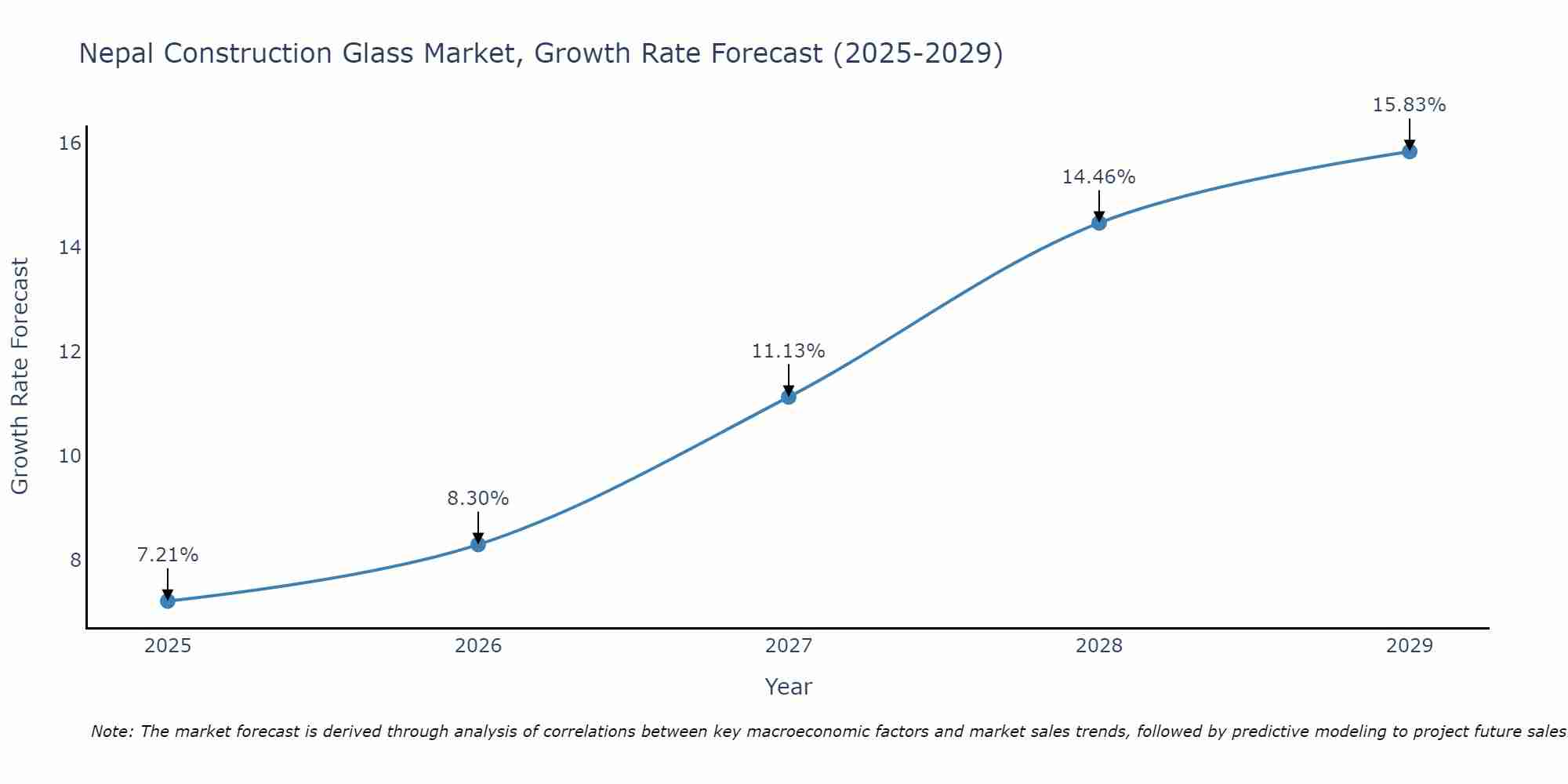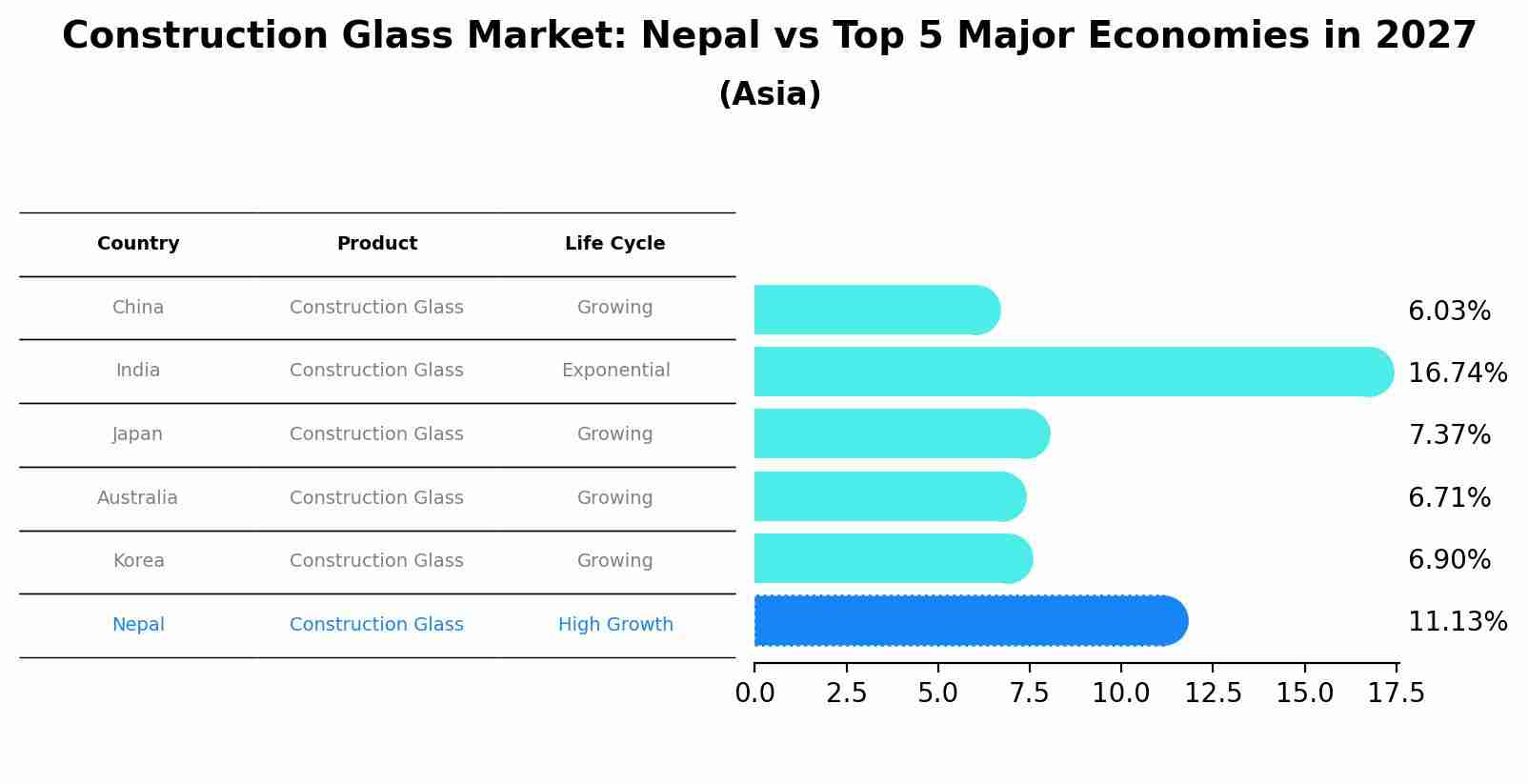Nepal Construction Glass Market (2025-2031) Outlook | Growth, Forecast, Industry, Size, Share, Value, Trends, Companies, Revenue & Analysis
| Product Code: ETC355356 | Publication Date: Aug 2022 | Updated Date: Aug 2025 | Product Type: Market Research Report | |
| Publisher: 6Wresearch | Author: Shubham Padhi | No. of Pages: 75 | No. of Figures: 35 | No. of Tables: 20 |
Nepal Construction Glass Market Size Growth Rate
The Nepal Construction Glass Market is likely to experience consistent growth rate gains over the period 2025 to 2029. From 7.21% in 2025, the growth rate steadily ascends to 15.83% in 2029.

Construction Glass Market: Nepal vs Top 5 Major Economies in 2027 (Asia)
By 2027, the Construction Glass market in Nepal is anticipated to reach a growth rate of 11.13%, as part of an increasingly competitive Asia region, where China remains at the forefront, supported by India, Japan, Australia and South Korea, driving innovations and market adoption across sectors.

Nepal Construction Glass Market Synopsis
The Nepal Construction Glass Market is experiencing steady growth driven by increasing construction activities across residential, commercial, and infrastructure sectors. The demand for energy-efficient and sustainable glass products is on the rise, leading to a shift towards high-performance insulated glass units and low-emissivity glass. Urbanization and a growing middle-class population are also contributing factors to the market expansion. Key players in the market are focusing on product innovation, such as self-cleaning and solar control glass, to cater to the evolving needs of the construction industry. Additionally, government initiatives promoting green buildings and energy efficiency are expected to further boost the demand for construction glass in Nepal. Overall, the market presents opportunities for manufacturers to capitalize on the growing construction sector and increasing consumer preference for advanced glass solutions.
Nepal Construction Glass Market Trends
The Nepal Construction Glass Market is experiencing significant growth due to the booming construction industry in the country. The demand for energy-efficient and sustainable building materials has propelled the adoption of advanced glass technologies such as low-emissivity glass and insulated glass units. Additionally, there is a rising trend towards using decorative and safety glass in architectural designs to enhance aesthetics and ensure safety in buildings. The market is also witnessing an increasing preference for larger glass panels and customized solutions to meet the evolving needs of modern construction projects. With the government`s focus on infrastructure development and urbanization projects, the construction glass market in Nepal is expected to continue its upward trajectory in the coming years.
Nepal Construction Glass Market Challenges
In the Nepal Construction Glass Market, some of the key challenges faced include fluctuating raw material prices, lack of skilled labor for installation, and inconsistent quality standards. The volatility in raw material prices, such as those for silica and soda ash, can impact production costs and ultimately pricing for consumers. Additionally, the shortage of skilled workers specialized in glass installation can lead to delays and lower quality workmanship, affecting project timelines and customer satisfaction. Furthermore, the absence of consistent quality standards across the industry can result in varying product quality and performance, making it difficult for consumers to make informed decisions. Addressing these challenges will be crucial for the sustainable growth and competitiveness of the construction glass market in Nepal.
Nepal Construction Glass Market Investment Opportunities
The Nepal Construction Glass Market offers lucrative investment opportunities due to the country`s growing infrastructure development and construction activities. With increasing urbanization and a rise in commercial and residential construction projects, there is a high demand for high-quality construction glass products. Investing in manufacturing plants or distribution channels for construction glass in Nepal can be a promising venture. Additionally, advancements in technology have led to the development of energy-efficient and sustainable glass solutions, further driving market growth. Collaborating with local construction companies or developers to provide innovative glass solutions tailored to the Nepalese market can also be a strategic investment opportunity in this sector. Overall, the Nepal Construction Glass Market presents potential for growth and profitability for investors looking to capitalize on the country`s construction boom.
Jordan Agar Market Government Policies
The government of Nepal has implemented various policies to regulate and promote the construction glass market in the country. These policies include setting standards for the quality and safety of construction glass products, providing incentives and subsidies for the use of energy-efficient and sustainable glass materials, and promoting research and development in the glass industry. Additionally, the government has introduced measures to support local manufacturers and reduce dependency on imports by imposing tariffs on imported glass products. Overall, these policies aim to enhance the competitiveness of the domestic construction glass market, promote environmentally friendly practices, and ensure the safety and durability of glass products used in construction projects across Nepal.
Nepal Construction Glass Market Future Outlook
The Nepal Construction Glass Market is expected to witness steady growth in the coming years due to increasing construction activities in the country. The growing demand for energy-efficient and sustainable building materials, coupled with the government`s focus on infrastructure development, will drive the market. Additionally, the rising disposable income of consumers and changing lifestyles are expected to boost the demand for aesthetically appealing glass products in the construction sector. Technological advancements in glass manufacturing, such as the development of smart glass and energy-efficient glazing solutions, will also contribute to the market growth. Overall, the Nepal Construction Glass Market is poised for expansion, with opportunities for market players to innovate and cater to the evolving needs of the construction industry.
Key Highlights of the Report:
- Nepal Construction Glass Market Outlook
- Market Size of Nepal Construction Glass Market, 2024
- Forecast of Nepal Construction Glass Market, 2031
- Historical Data and Forecast of Nepal Construction Glass Revenues & Volume for the Period 2021 - 2031
- Nepal Construction Glass Market Trend Evolution
- Nepal Construction Glass Market Drivers and Challenges
- Nepal Construction Glass Price Trends
- Nepal Construction Glass Porter's Five Forces
- Nepal Construction Glass Industry Life Cycle
- Historical Data and Forecast of Nepal Construction Glass Market Revenues & Volume By Chemical Composition for the Period 2021 - 2031
- Historical Data and Forecast of Nepal Construction Glass Market Revenues & Volume By Soda-lime for the Period 2021 - 2031
- Historical Data and Forecast of Nepal Construction Glass Market Revenues & Volume By Potash-lime for the Period 2021 - 2031
- Historical Data and Forecast of Nepal Construction Glass Market Revenues & Volume By Potash-lead for the Period 2021 - 2031
- Historical Data and Forecast of Nepal Construction Glass Market Revenues & Volume By Type for the Period 2021 - 2031
- Historical Data and Forecast of Nepal Construction Glass Market Revenues & Volume By Low-e Glass for the Period 2021 - 2031
- Historical Data and Forecast of Nepal Construction Glass Market Revenues & Volume By Special Glass for the Period 2021 - 2031
- Historical Data and Forecast of Nepal Construction Glass Market Revenues & Volume By Manufacturing Process for the Period 2021 - 2031
- Historical Data and Forecast of Nepal Construction Glass Market Revenues & Volume By Float Process for the Period 2021 - 2031
- Historical Data and Forecast of Nepal Construction Glass Market Revenues & Volume By Rolled/sheet Process for the Period 2021 - 2031
- Historical Data and Forecast of Nepal Construction Glass Market Revenues & Volume By Application for the Period 2021 - 2031
- Historical Data and Forecast of Nepal Construction Glass Market Revenues & Volume By Residential for the Period 2021 - 2031
- Historical Data and Forecast of Nepal Construction Glass Market Revenues & Volume By Commercial for the Period 2021 - 2031
- Historical Data and Forecast of Nepal Construction Glass Market Revenues & Volume By Others for the Period 2021 - 2031
- Nepal Construction Glass Import Export Trade Statistics
- Market Opportunity Assessment By Chemical Composition
- Market Opportunity Assessment By Type
- Market Opportunity Assessment By Manufacturing Process
- Market Opportunity Assessment By Application
- Nepal Construction Glass Top Companies Market Share
- Nepal Construction Glass Competitive Benchmarking By Technical and Operational Parameters
- Nepal Construction Glass Company Profiles
- Nepal Construction Glass Key Strategic Recommendations
Frequently Asked Questions About the Market Study (FAQs):
- Single User License$ 1,995
- Department License$ 2,400
- Site License$ 3,120
- Global License$ 3,795
Search
Thought Leadership and Analyst Meet
Our Clients
Related Reports
- Afghanistan Apparel Market (2026-2032) | Growth, Outlook, Industry, Segmentation, Forecast, Size, Companies, Trends, Value, Share, Analysis & Revenue
- Canada Oil and Gas Market (2026-2032) | Share, Segmentation, Value, Industry, Trends, Forecast, Analysis, Size & Revenue, Growth, Competitive Landscape, Outlook, Companies
- Germany Breakfast Food Market (2026-2032) | Industry, Share, Growth, Size, Companies, Value, Analysis, Revenue, Trends, Forecast & Outlook
- Australia Briquette Market (2025-2031) | Growth, Size, Revenue, Forecast, Analysis, Trends, Value, Share, Industry & Companies
- Vietnam System Integrator Market (2025-2031) | Size, Companies, Analysis, Industry, Value, Forecast, Growth, Trends, Revenue & Share
- ASEAN and Thailand Brain Health Supplements Market (2025-2031) | Strategy, Consumer Insights, Analysis, Investment Trends, Opportunities, Growth, Size, Share, Industry, Revenue, Segments, Value, Segmentation, Supply, Forecast, Restraints, Outlook, Competition, Drivers, Trends, Demand, Pricing Analysis, Competitive, Strategic Insights, Companies, Challenges
- ASEAN Bearings Market (2025-2031) | Strategy, Consumer Insights, Analysis, Investment Trends, Opportunities, Growth, Size, Share, Industry, Revenue, Segments, Value, Segmentation, Supply, Forecast, Restraints, Outlook, Competition, Drivers, Trends, Demand, Pricing Analysis, Competitive, Strategic Insights, Companies, Challenges
- Europe Flooring Market (2025-2031) | Outlook, Share, Industry, Trends, Forecast, Companies, Revenue, Size, Analysis, Growth & Value
- Saudi Arabia Manlift Market (2025-2031) | Outlook, Size, Growth, Trends, Companies, Industry, Revenue, Value, Share, Forecast & Analysis
- Uganda Excavator, Crane, and Wheel Loaders Market (2025-2031) | Strategy, Consumer Insights, Analysis, Investment Trends, Opportunities, Growth, Size, Share, Industry, Revenue, Segments, Value, Segmentation, Supply, Forecast, Restraints, Outlook, Competition, Drivers, Trends, Demand, Pricing Analysis, Competitive, Strategic Insights, Companies, Challenges
Industry Events and Analyst Meet
Whitepaper
- Middle East & Africa Commercial Security Market Click here to view more.
- Middle East & Africa Fire Safety Systems & Equipment Market Click here to view more.
- GCC Drone Market Click here to view more.
- Middle East Lighting Fixture Market Click here to view more.
- GCC Physical & Perimeter Security Market Click here to view more.
6WResearch In News
- Doha a strategic location for EV manufacturing hub: IPA Qatar
- Demand for luxury TVs surging in the GCC, says Samsung
- Empowering Growth: The Thriving Journey of Bangladesh’s Cable Industry
- Demand for luxury TVs surging in the GCC, says Samsung
- Video call with a traditional healer? Once unthinkable, it’s now common in South Africa
- Intelligent Buildings To Smooth GCC’s Path To Net Zero


















